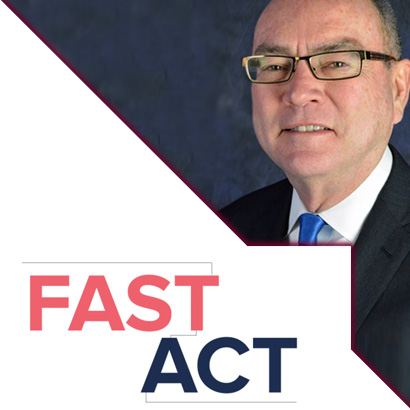 On Friday, December 4th, President Obama signed into law the“Fixing America’s Surface Transportation” or “FAST” Act, the first long-term transportation bill the U.S. has seen in ten years. The $305 billion, 5-year program comes as a welcome bi-partisan compromise, but as with any major piece of legislation, it comes with its fair share of controversy.
On Friday, December 4th, President Obama signed into law the“Fixing America’s Surface Transportation” or “FAST” Act, the first long-term transportation bill the U.S. has seen in ten years. The $305 billion, 5-year program comes as a welcome bi-partisan compromise, but as with any major piece of legislation, it comes with its fair share of controversy.
Frederick G. “Bud” Wright is Executive Director of the American Association of State Highway and Transportation Officials (AASHTO), a non-profit, non-partisan association which advocates transportation-related policies and provides technical services to support states in their efforts to efficiently and safely move people and goods. He has almost four decades of experience in both the private sector and as a top executive at the Federal Highway Administration.
The FAST Act: Progress but Not Perfect
It’s not everything we dreamed of, but it is most definitely progress. This is the first time in over a decade that we’ve had a 5-year—or multi-year— reauthorization, something that state DOTs and others who have the responsibility for planning transportation investments can now rely on…So definitely a major step forward, but it’s also not the perfect bill…there are some things that are lacking and one of them is the fact that it did not identify a sustainable, long-term source of revenue to support federal surface transportation investment…
States Still Rely on Federal Transportation Dollars
Every state has its own department of transportation, and also has its own resources from state sources. Many local governments also have tax bases that they use to support surface transportation investment. The federal program is an additional component to that, It, on average, amounts to about 50% of the capital investment in surface transportation that takes place in the country. But that varies pretty dramatically from state to state. In some states it’s as high as 90% of their capital program.
The Job’s Not Done for Transportation Advocates
I think all of those who have been surface transportation advocates have in fact been heard by the Congress, because they are supportive of this program, but that said, many of those same groups who are advocating for transportation investment have also made the point that what we really need is that sustainable source of revenue for the longer term. And the Congress did not address that issue. They chose to use what revenues do flow into the Highway Trust Fund but are insufficient to support today’s program levels and supplement those with general funds.
What Does Transportation Mean for Me?
I think one of the keys to the success in convincing the Congress is that we really do have to drill transportation down to what does it mean for me as a citizen, as an individual. When we tend to talk about transportation needs in terms of billions or even trillions of dollars, I think that’s hard for the average person to get their arms around. But when we talk about it in terms of here’s a specific improvement that can and will result from your willingness to invest, then I think people say, “Okay that’s something that I am willing to support.”
Download full transcript (PDF): Our Future with the FAST Act: Bud Wright
Tags: AASHTO, American Association of State Highway and Transportation Officials, Bud Wright, Frederick G. Wright






 RSS Feed
RSS Feed
There needs to be more money spent on highway safety. It is always a great talking point by all those trying to get elected or reelected but NEVER properly funded. WHY?